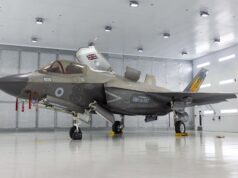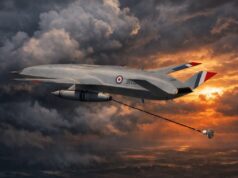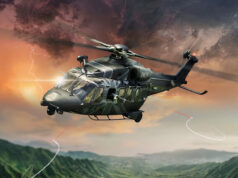The U.S. Air Force say that the 96th Test Wing and 53rd Wing welcomed the first three F-16 Fighting Falcons ready to take part in the Viper Experimentation and Next-gen Operations Model – Autonomy Flying Testbed programme.
VENOM-AFT is designed and funded to accelerate testing of autonomy software on crewed and uncrewed aircraft.
VENOM-AFT complements the Autonomy Data and AI Experimentation proving ground at Eglin and informs the Collaborative Combat Aircraft program and other autonomy developers.
The next step for the VENOM program is to modify the F-16 aircraft into test platforms to rapidly evaluate autonomous capabilities.
“The VENOM program marks a pivotal chapter in the advancement of aerial combat capabilities. This transformative program holds the potential to redefine air combat paradigms by fostering novel autonomous functions for current and future crewed and uncrewed platforms,” said Maj. Ross Elder, VENOM developmental test lead.
“We look forward to the culmination of years of engineering and collaboration, as VENOM leads a measured step towards a new age of aviation.”
During these tests, the pilots will be in the cockpit to monitor the autonomy and ensures flight and mission systems test objectives are met.
“It’s important to understand the ‘human-on-the-loop’ aspect of this type of testing, meaning that a pilot will be involved in the autonomy in real time and maintain the ability to start and stop specific algorithms,” said Lt. Col. Joe Gagnon, 85th TES commander.
“There will never be a time where the VENOM aircraft will solely ‘fly by itself’ without a human component.”
Operators will provide feedback during modeling, simulation, and post-flight to the autonomy developers to improve performance over time and ensure the autonomy is making the appropriate decisions prior to and during flight. The goal of the VENOM program is to enable the Air Force to rapidly iterate and expand the body of knowledge for potential autonomy and payload solutions.













Perhaps we should send them some T1 Typhoons?
I have been thinking much the same.
Make a great missile or bomb truck loyal wingman.
👍
I doubt they would do it for free. We might as well do it ourselves.
Us? Never. 🙃
Typhoon T1 has too few airframes. Also, the MOD would want to keep parts that will be useful on other aircraft. F-16 has had decades of refined experience, logistics/supply chain and spares behind it and can more likely be replaced. Also, too many different aircraft will make maintenance training, armament types, and pilot training more complicated. Poland, Slovakia and Romania operate the F-16 and can offer immediate spares if needed in an emergency.
Additional: I’m not sure where I was going with armament types. Oh, the F-16 is cheaper to operate per hour than the Eurofighter.
Sounds like testing and experimentation that will benefit ‘optionally manned’ platforms too.
Seems like a great idea. There is always talk of how expensive it is to train fast jet pilots, so taking them out of harms way would mean that should a jet be lost in combat, they could just roll another one straight out the hanger for the “pilot in the porta-cabin” to keep going.
It would also help ensure that all pilots would be able to make it to the Mess for “tea and medals” 😀😀😀
Why do I suspect the next testing phase will be in Ukraine?
Sounds good to me👍
Would have thought it would make already expensive planes much more expensive. You take a plane that add a whole lot more expensive stuff to make it “optionally manned.” I think you need planes and drones, but not an amalgamation of both.
That said, I’m still wondering how a pilot with “loyal wingmen” is going to control his own plane in combat and a whole bunch of drones at the same time.
It really depends.. the f16 is coming into its twilight years and there are lots and lots of second hand one and they are easy to maintain and cheap to operate.. if you could convert them to drones for a reasonable price ( say anything around the 50million a pop mark) you have the perfect high end but cheap ish loyal wing man.
Converting a F-16 to unmanned operation should cost a lot less than £50m each! That really is not cheap.
I depends what the ground stations ect would cost and drone technology seems to be very costly..when you think protector comes in at around 99-167 million a pop…and the protector airframe is nothing to write home about….so i suspect you would not turn a F16 into a fully fledged drone with autonomous functions for south of 50million.
I suspect all the planes would be autonomous just leaving the pilot to make decisions. eg. Destroy x or let’s go home
Pilot on the ground in a control station?
In the air or on the ground. The only advantage of being in the air is to bring the decision maker closer to the action and limit the ability of enemy to cut communications.
Your airborne pilot is controlling a number of loyal wingmen? His own plane is being flown by a computer?
Autopilot if you like (in his own plane and in the wingmen).
Workload on the pilot will be very high. Not sure anyone will proceed with this idea.
When you program planes to fly themselves as would be necessary for UAVs then the computer would be doing most of the leg work. Instructions are needed for issues like destination, what should be engaged etc. but the computer(s) will be doing most of the work. Take off, landing, etc. would be all automated. Might even get a little boring for the pilot.
Thanks. The key driver to make platforms unmanned is to reduce or eliminate the risk of losing the human crew. Yet the loyal wingman concept retains a human crew on the airborne ‘mothership’. A bit puzzling.
More importantly, most combat casualties are incurred by Land Forces, especially Infantry, but also combat engineers. Surely they are better candidates for unmanned operations, if we are trying to save maximum numbers of human lives?
I suspect one of the key drivers here is the suppliers. Many of the key aspects eg. Fly by wire etc. already exists in the aerospace sector. Less so for ground forces. Also I suppose you could argue that control of the air means greater safety on the ground.
There has been some significant progress with ground foces mainly in the area of robotics however not as much as might be expected. I suspect that some progress will emerge over time with investment. There is also the out of control AI factor to consider. Firms may consider any investment might be wasted if a treaty comes to pass and the automation element is too high.
Mark, I have to declare an interest. I was the SO2 in the unmanned ground vehicles group at RARDE Chertsey back in the day, 1989-90. Our R&D was at least 10-15 years ahead of civvy street, but the army was too conservative to embrace the possibilities.
Yes. I was working with the IT companies back then and things were evolving rapidly. That said if you compare what is available today to what was available then you would be quite shocked I suspect. That said the problem is really still the same – the people holding the purse strings don’t understand what is achievable.
Thanks Mark. I think the purse string holders do know what is achievable as there have been many demonstrations of UGVs in the UK over the years.
I just don’t think the Army staff push it hard. There may be a reason…
Politicians and bean-counters would doubtless consider UGVs to be a way of reducing the human manpower count yet further!
Yes there is perhaps an element of that.
If that is their policy perhaps they haven’t thought it through. Due to the low recruitment and the political will to ship existing kit off to Ukraine the Army might be left with even less than they have at the moment. UGVs might be a way to increase the lethality of their forces and at a fraction of the expected cost. The Army might be left with little choice.
It is true to say though that the Army need to expand their supplier base to include far more new SMEs. They will likely be the source of inexpensive cutting edge UGVs and their components.
I don’t believe that we would supply Ukraine with so many platforms that we would be short ourselves; we only gifted 14 tanks out of 227 active list tanks. The drawdown of the army’s manpower has not been fully matched with equipment drawdown so we have more equipment than we can man.
I don’t think UGVs necessarily increase lethality or are particularly inexpensive.
Hence the reason we need new suppliers to drive down costs. We also need to be prepared to buy in quantity. New tech tends to provide new ways of attacking a target to exploit existing weaknesses. I suppose the length of the conflict and the support from other countries will dictate how much of our existing kit we send but will also highlight shortcomings in the design of exist kit.
Scary things technology, may be try it out on old tranche tornadoes as test drones with weapons ,I know endless possibilities for this kinda tech ,imagine giving Ukraine a few old squadrons of tornadoes this kinda stuff big,big suicide drones ,would cover a nice distance to Mr Vladimir Vladimirich putin run them right into the kremlin ,lol
With a tomahawk just behind it
Bang on Andy,never thought of that one 👏 👌 👍 🤣
Interesting to see how the USN are now designating the freedom class LCSS as a frigate. The ships numbers 21 upwards have been retrofitted with the gearing coupling fix. The class is now being used within the 5th and 6th fleets as an escort ship and are said to be operating well . The plans to retire the class presents a real opportunity for anyone looking at increasing the size of its fleet. I would imagine that buying a couple of them would be a good move especially if they come with the option to purchase more as they become available.. using some of the equipment from the retired T23’s such as the mk 8 gun(swap it with the paltry 57mm on the freedom), which could then be fitted onto a river class. The NSM instead of the harpoon and perhaps the essm seawolf, could be fitted, plus the TORPEDO systems they’ve had more than a little controversy around them, but so did the royal navy in the type 45 class. If anyone is going to get the best out of the ships, it’s the RN. Plus they are built and could bridge the gaps as the T25, and the T31 are rolled out I drive a foreign car and I watch a foreign television, why shouldn’t the British armed forces do it. Too? the only made in Britain policy does the navy no good, especially when there’s no places to build them
They basically gave up the idea of swapping modules and designated one class for MCM and the other for ASW.
It’s still way to loud too really perform ASW but then if your going up against Iranian or Chinese boats you don’t need to be that good.
They would be zero use in the North Atlantic but then that’s what the RN is for.
I think they gave up on the sub surface module as the towed array was about as stable as a bag on a windy day.
Happy to be wrong though.
The USA is retiring some fast transport ships, spearhead class which could be great for getting things across the channel, North Sea etc quickly. All quite young aswell.
Ahem. Please discuss manning g and running costs and if you could, talk about the price of maintenance.
The 57mm is a far more useful weapon than the Mk8 Andy…the mk 8 is literally only now naval gunfire support ( and if the war in Ukraine has show anything it’s hanging around in the littoral is now a bad idea) or anti surface warfare…which the 57mm can do better with advanced fusing options..the MK8 can no longer do any Anti air…which the 57mm is very good at…basically the RN Could do a lot worse than changing out its remaining mk8s with 57mm bofors.
Yeah the 114mm 4.5″/55-calibre Mark 8 was in introduced in 1972 as a replacement for the older WW2 and Cold War era 114mm QF 4.5″/45-calibre Mark 1 to 6 guns
If you could convert all those all legacy f16s into resonantly priced high end drones that would be a remarkable achievement….the world has plenty of unwanted f16s coming on the market..instead of wasting a fortune building a whole new set of high end heavy drones you could reuse….
Still a tremendous waste of human flight capability emulating a cruise missile. The anti-missile defence systems can be stressed by flight manoeuvres that no human can withstand even with the G-Suit.
Hypersonic missiles with agile manoeuvres are in development for that.
Adding satellite uplink for remote piloting that’s already in service with drones so maybe there’s a short cut available though if I recall correctly Lockheed Martin are not involved with the Drones in service.
I would expect some reluctance to put state of the art satellite uplink tech in harms way in Ukraine which is why we mostly supply end of life but capable weapons.
I was not thinking about them as attritional sucide drones, more as a cheap alternative to a loyal wingman…at present the loyal wingman programs are all looking as expensive as the human manned jets they will be supporting which defeats the point of a loyal wingman drone…100-150 million is not something you can risk losing..but if you can find something for half the price it’s not throw away but you can contemplate losing a few.
Fair point.
The problem with innovation is separating the costs of research and development from serial production.
The JSF programme uses low rate production batches to try to square that circle with some success but deciding who takes the risk will always be difficult.
So F16 reuse is like the Grippen modular concept that separates the flight control system from avionics for defence and attack which can change without a new type approval test cycle.
Nobody would buy with the R&D costs sunk in a few prototype aircraft as the unit cost. Those aircraft are on their way to a museum without the secret bits after serial production starts with sunk cost reallocated…
Is this idea of converting older aircraft into a big RC aircraft anything new. Not really. If I remember correctly it was tried out in WW1 with Low and De-Havilland then in WW2 with a tv camara and RC controls, I think it was a B-17.
However there is a major problem with a drone, SIGNALS. This is my area so I know. If I can detect the signal use more power I get control, simple terms but good for people to understand. The only way it could work is if the control signal is a line of sight signal. This would mean a control aircraft in the air, and operators in the aircraft. Or you give the drone a preflight control path and send it on its way.
The idea is good but AI is not yet up to the job.
Ai says, hold my beer….
I imagine this is where your fifth generation f35 hub comes into its own….line of sight is easy between two aircraft ( no irritating horizon of hills to get in the way)….in the end even if your radiating and the enemy knows your somewhere it’s still going to have different finding the fifth generation aircraft in a way it can get a kill chain…all the drones are still a problem….and if you EW the environment…it makes life easy for the AI…kill the EW source is an easy instruction to follow.
Cruie missiles have been able to fly themselves very long distances to a target without hitting a mountain, zoom in on a high-value target and destroy it – for decades now.
Why is it hard to do similar with a full size aircraft? [Clearly you do not suicide-crash the F-16 ‘drone’ into the target – you fire some missiles at target]
The communication problem for remote piloting is already solved and FOC in RAF and USAF service. Drones with satellite uplink means that control from a ground station by a pilot is proven.
However the loyal wingman is different because the flight control and basic tactical abilities are supposed to be onboard with the human wingman there to make decisions that the AI is not competent to do.
So pilot of your own aircraft and weapons systems officer of your loyal wingman seems like more workload untill you account for increased automation across both, and not literally being in harms way for every engagement of the enemy.
I suspect you still have to put the kill decals on the loyal wingman if it made the shot..
The guardian today has an interesting article on how their AI ‘Lavender’ identifys bombing targets for Israel, 37000 of them.
If we had adopted Israeli methodology during ‘the Troubles’ then we would have had Tornadoes bombing the Creggan in Londonderry and the Divis flats in Belfast.
It doesn’t bear thinking about.